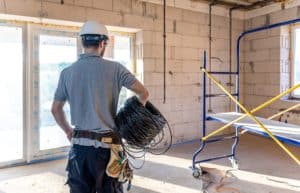As a contractor, small business owner, or artisan, navigating the often-confusing world of insurance coverage can be overwhelming. Builder’s Risk Insurance, often referred to as Course of Construction insurance, is a non-standardized, tailor-made insurance policy that provides specific coverage for your unique construction risks.
Contractor general liability insurance and worker compensation policies cover onsite accidents and mishaps while protecting you from any possible litigation. However, neither of these insurance vehicles offer any protection in the event of a fire and virtually no coverage whatsoever for damage and vandalism of equipment, material, and supplies.
Builder’s risk insurance is a customizable policy where you and your insurer sit down and define exactly the kind of coverage your unique construction or renovation project needs. So, what makes a good builder’s risk insurance policy?
1. Cover Existing Infrastructure and New Construction
It is not enough just to have insurance for the renovation or construction portion your small business is performing. Your policy should also cover the existing building and its infrastructure. Without this essential coverage, your business could be liable for any damages incurred to your renovation and the building itself.
It is common for both the building and construction site to become exposed to extreme weather like rain, wind, snow, sleet, and freezing temperatures. No contractor wants to deal with water damage from excessive rainfall or damaged pipes caused by below-freezing temperatures. Accounting for these weather-related risks is an absolute must-have in any builder’s risk insurance policy.
2. Project Delays Equal Soft Costs
Delays are commonplace in the construction industry; only 30% of contractors finish their construction projects on time and within budget. These delays have a cascading effect on a project’s costs. Increased raw material and supply costs, higher financing, increased real-estate fees, lost income on incomplete rental units, and redesigns of existing plans, are all constant concerns for contractors.
While most delays are resolved relatively quickly, it is still prudent that your policy covers your business if the project’s timeline goes beyond a reasonable period. Soft costs can quickly get out of hand if not properly addressed.
3. Equipment, Material, and Supplies
More often than not, you will have to leave equipment, material, and supplies on-site unattended. All of these run the risk of theft or damage, but material and supplies are especially susceptible to material degradation. Your policy should not only provide coverage in cases of vandalism and theft but should also cover the effects of extreme weather on your material and supplies.
Your insurer might provide rebates or reductions if you use
- heavy-duty fencing around the job site,
- remote monitoring,
- or keep your material, supplies, and equipment within large enclosures.
All of these are preventative measures that could lower your insurance costs and premiums.
4. Testing, Testing, Testing
Regardless of their size or scope, construction and renovation projects represent a large number of inherent insurance risks. One of them includes the intermittent testing of existing work throughout the project. This might include your subcontractors testing newly-installed electrical junction boxes or a plumber running the water after all the plumbing is completed.
If you are doing a renovation on a single unit, then you could be liable for electrical or water damage to the construction project and the building itself if your builder’s risk insurance policy is not properly structured.
5. Transit to and From Job Site
Depending upon the type of construction project you are involved in, you may need to transport extremely expensive equipment and materials. Anything can happen in transit. Even the process of loading and unloading presents its own set of challenges and dangers.
Regardless of what you are transporting, your builder’s risk insurance policy should include provisions in the event of an accident or damage to the in-transit materials and equipment. Something well-written and easy-to-understand is what makes a good builder’s risk insurance policy, and should clearly outline the coverage for all parties involved.
This means that parties named on the policy might include:
- Your business
- Your Subcontractors
- The owner of the building
- The financial institution that is funding the project
- Some engineers or architects
Get in touch with Bethany Insurance to see how a good builders’ risk insurance policy can give you extra support and peace of mind.




